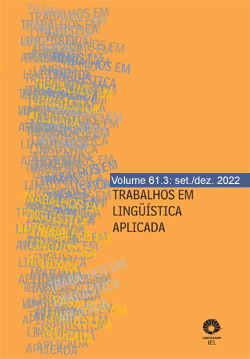Abstract
This paper is based on research of a sociolinguistic and ethnographic nature, which was carried out with young migrants from Timor-Leste, who were based in a small town in Northern Ireland (CABRAL; MARTIN-JONES, 2017). Through this research we traced their migration trajectories (via Portugal or England), and we documented the agentive ways in which they were dealing with local conditions of settlement and employment, and, at the same time, creating new spaces of solidarity and conviviality within local life worlds. We focus here on one particular life world – that of sport – and on the nine football clubs formed for Timorese men and boys in this local Irish setting. We describe and analyse three different aspects of the communicative practices that were developing around the football: (1.) The linguistic, cultural and semiotic practices involved in the naming and branding of the clubs e.g., practices that indexed different Timorese identities (from different regions of Timor-Leste) and practices that indexed different globalised cultural worlds of football; (2.) the language resources of the Timorese club managers (including Tetum, Portuguese and English), and their organisational practices, their ethos and their funds of knowledge; (3.) the significance of the scheduling of football tournaments around key dates in the establishment of the nation of Timor-Leste – a regular practice that indexed an orientation to a shared national origin.
References
ADEY, P. (2006). If mobility is everything then it is nothing: towards a relational politics of (im)mobilities. Mobilities, v. 1, n. 1, p. 75-94.
AHMED, S.; CASTANEDA, C.; FORTIER, A.M.; SHELLER, M. (eds.). (2003). Uprootings/ regroundings: Questions of home and migration. Oxford: Berg.
APPADURAI, A. (1996). Modernity at large: Cultural dimensions of globalization. Minneapolis: University of Minnesota Press.
BLOMMAERT, J. (2010). The sociolinguistics of globalization. Cambridge: Cambridge University Press.
BRAH, A. (1996). Cartographies of diaspora: Contesting identities. London: Routledge.
BRENNER, N. (2004). New state spaces, urban governance and the re-scaling of statehood. Oxford: Oxford University Press.
BUDIARDJO, C.; LIONG, L. S. (1984). The war against East Timor. Zed Books, London.
CABRAL, E. (2013). “The development of language policy in a global age”. In ARTHUR SHOBA. J.; CHIMBUTANE, F. (eds.) Bilingual education and language policy in the global south. New York: Routledge, p. 83 – 103.
CABRAL, E.; MARTIN-JONES, M. (2008). “Writing the Resistance: Literacy in East Timor 19751999”. International Journal of Bilingual Education and Bilingualism, v. 11, n. 2, p. 149-169.
CABRAL, E.; MARTIN-JONES, M. (2017). Moving north, navigating new work worlds, and re-mooring: Language and other semiotic resources in the migration trajectories of East Timorese in the UK. In KERFOOT, C.; HYLTENSTAM, K. (eds.) Entangled discourses: South-North orders of visibility. New York: Routledge, p. 79-98.
CASTELLS, M. (2000). The information age: Economy, society and culture. Oxford: Blackwell.
CRESSWELL, T. (2002). Introduction: theorizing place. In Verstraete, G.; Cresswell, T. (eds.) Mobilizing place, placing mobility. Amsterdam: Rodopi.
CORRIGAN, K. P.; MEARNS, A.J.; THORBURN, J. (2015). From home to here: Stories of migration old and new. Belfast: Nicholson Bass.
COUPLAND, N. (ed.). (2003). Sociolinguistics and globalization. Journal of Sociolinguistics v. 7, n. 4, p. 465 – 472.
Da COSTA CABRAL, I. (2010). From Dili to Dungannon: A case study of two bilingual migrant families from East Timor. Unpublished MA dissertation, University of Birmingham (UK).
DOYLE, C.; McAREAVEY, R. (2016). Patterns and processes of recent migration in Northern Ireland. Irish Geography, v. 49, n. 1, p. 47-72.
DUCHÊNE, A.; HELLER, M. (eds.). (2012). Language in late capitalism: Pride and profit. New York: Routledge.
DUCHÊNE, A.; MOYER, M.; ROBERTS, C. (eds.). (2013). Language, migration and social inequalities. Bristol: Multilingual Matters.
GILROY, P. (2004). After Empire: Melancholia or convivial culture. London: Routledge.
HABERMAS, J. (1987) The theory of communicative action, Volume 2, Lifeworld and system: A critique of functionalist reason. London: Heinemann.
FERNANDES, C. (2011). The Independence of East-Timor. Brighton: Sussex Academic Press.
FORTIER, A.M (2000). Migrant belongings: Memory, space, identity. Oxford: Berg.
HANNAM, K.; SHELLER, M.; URRY, J. (2006). Editorial: mobilities, immobilities and moorings. Mobilities, v. 1, n. 1, p. 1-22.
HARVEY, D. (1989). The condition of postmodernity. Oxford: Blackwell.
HANNERZ, U. (1996). Transnational connections. London and New York: Routledge.
HELLER, M. (2007). Bilingualism as ideology and practice. In Heller, M. (ed.) Bilingualism: A social approach. Basingstoke, Hampshire: Palgrave Macmillan, 1-22.
HELLER, M. (2011). Paths to post-nationalism: A critical ethnography of language and identity. Oxford: Oxford University Press.
HELLER, M.; BELL, L.A.; DAVELUY, M.; McLAUGHLIN, M; NOËL, H. (2016). Sustaining the nation: The making and moving of language and nation. Oxford: Oxford University Press.
KRESS, G. (2010). Multimodality: A social semiotic approach to communication. London: Routledge.
LEACH, M. (2017). Nation-building and national identity in Timor-Leste. Abingdon, Oxon: Routledge.
McWILLIAM, A. (2022). Making money, missing home: Reflections on Timorese informal labour migration to Britain. The Asia Pacific Journal of Anthropology, v.23, n. 3, p.265-285.
PRATT, M.L (1987). Linguistic utopias. In Fabb, N.; Attridge, D; Duranti, A; MacCabe, C. (eds.) The linguistics of writing: Arguments between language and literature. Manchester: Manchester University Press.
SHUAIB, F. (2008). East Timor Country Report. Canberra, Australia: Department of Foreign Affairs and Trade. Available at: http://aid.dfat.gov.au/Publications/Documents/etimor_study.pdf Acessed: 9/3/ 2014.
STANDING, G. (2010). The precariat. London: Bloomsburg
TAYLOR, J.G. (1999). East Timor: The price of freedom. London: Zed Press.
URRY, J. (2007). Mobilities. Cambridge: Polity Press.
WENGER, E. (1998). Communities of practice: Learning, meaning and identity. New York: Cambridge University Press.

This work is licensed under a Creative Commons Attribution 4.0 International License.
Copyright (c) 2022 Trabalhos em Linguística Aplicada


